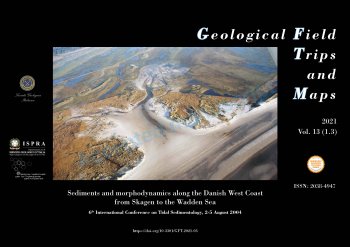
Volume 13 (1.3)/2021
Sediments and morphodynamics along the Danish West Coast from Skagen to the Wadden Sea
6th International Conference on Tidal Sedimentology, 2-5 August 2004
DOI: https://doi.org/10.3301/GFT.2021.03 - Pages: 1-51
Jesper Bartholdy (1), Troels Aagaard (1), Christian Christiansen (1a), Peter N. Johannessen (2), Lars H. Nielsen (2), Jørn B. T. Pedersen (1), Kaj S. Petersen (2a), Niels Vinther (1) & Katie Szkornik (3b)
(1) - Institute of Geography, University of Copenhagen, Øster Voldgade 10, 1350 Copenhagen K, Denmark.
(2) - Geological Survey of Denmark and Greenland (GEUS), Øster Voldgade 10, 1350 Copenhagen K, Denmark. (a) Retired.
(3) - School of Geography, University of Plymouth, Drake Circus, Plymouth, PL4 8AA, United Kingdom. (b) Now: School of Geography, Geology and Environment, Keele University.
(2) - Geological Survey of Denmark and Greenland (GEUS), Øster Voldgade 10, 1350 Copenhagen K, Denmark. (a) Retired.
(3) - School of Geography, University of Plymouth, Drake Circus, Plymouth, PL4 8AA, United Kingdom. (b) Now: School of Geography, Geology and Environment, Keele University.
Abstract
The primary objectives of this field trip are to demonstrate relations between process, morphology and sediments on the Danish North Sea coast from the non-tidal Skagen Odde spit with a relative sea level drop of a few tenth of mm y-1 to the tidal Danish Wadden Sea with a relative sea level rise of about 2 mm y-1 . The tidal conditions along the Danish North Sea coast changes from almost non-tidal in the north to a tidal range of about 2 m in the south. The spit-system is presented by illustrating spit forming processes of today and coastal cliffs revealing preserved sedimentary facies and structures from earlier stages. Further south, coastal erosion releases large quantities of glacial sediments from eroding cliffs. The southern part of the Danish North Sea coast consists of the northernmost part of the Wadden Sea. The exposed coasts are fringed by prominent foredunes dissected by wash-over channels. The back-barriers consist of widespread salt marsh areas. Behind the salt-marsh, tidal flats and tidal channels form the intertidal area separating the Wadden Sea barrier islands from the main land. All typical geomorphological features will be visited using terrain going vehicles, rubber dinghies and a helicopter ride.
Keywords
Coastal geomorphology, sedimentary processes, sedimentary facies, none tidal to tidal morphodynamics, coastal processes, barrier islands, coastal erosion, tidal areas, isostasy.
